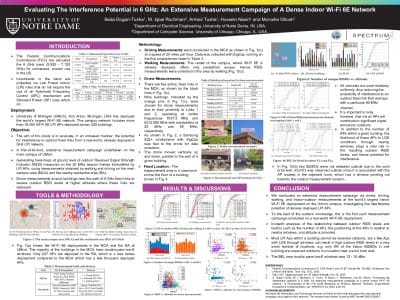Authors
Seda Dogan-Tusha, M. Iqbal Rochman, Armed Tusha, Hossein Nasiri and Monisha Ghosh
Abstract
The Federal Communications Commission (FCC) has allocated the 6 GHz band (5.925 – 7.125 GHz) for unlicensed, shared use in the US. Incumbents in the band are protected via Low Power Indoor (LPI) rules that do not require the use of an Automatic Frequency Control (AFC) mechanism and Standard Power (SP) rules which do. As the deployment of Wi-Fi 6E APs implementing LPI rules have been increasing, there is limited research examining the real-world interference potential of dense LPI deployments to fixed links, which remains a concern for incumbents. We have conducted a first-of-its-kind extensive measurement campaign of a dense indoor Wi-Fi 6E network at the University of Michigan, which includes walking, driving, and drone measurements to assess outdoor beacon Received Signal Strength Indicator (RSSI), building entry loss (BEL), channel utilization, and appropriate enabling signal level for a proposed client-to-client (C2C) mode in 6 GHz. Our detailed measurements under various conditions show median outdoor RSSI between -75 dBm and -85 dBm, BEL between 12 dB and 16 dB through double-pane low-emission windows, and only 5% of indoor Basic Service Set Identifiers (BSSIDs) observed outdoors. Our overall conclusion is that the probability of interference to incumbent fixed links is low, but more research is required to determine the appropriate signal level for the C2C enabling signal.

